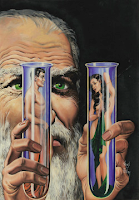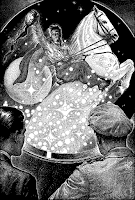Virgil Finlay (July 23, 1914 – January 18, 1971) died at the age of 56. From my perspective, as someone who is 56, that seems like a horribly young age for anyone to die. As a contemporary of
Jack Vance, Finlay created illustrations for some of Vance's early published stories.
 |
| New Bodies for Old |
Vance published "
New Bodies for Old" in the August 1950 issue of
Thrilling Wonder Stories. You can read the story
here. Roland Mario, lazy, affluent and bored, pays to have his mind transferred into the body of Ralston Ebery, an obese but wealthy industrialist and manufacturer of the Ebery Air-car. An employee of Ebery Air-car company is Letya Arnold, who has invented a faster-than-light spaceship propulsion system. After a year of hard work, Mario gets his old body back and he is ready to head for the stars.
Shown to the right is an interior illustration drawn by Finlay for
Abercrombie Station. Relax: our heroine
Jean escapes from the alien monsters.
In 1953, Vance published a short story called "
Sjambak" in the
July 1953 issue of If magazine. The interior illustration by Finlay (shown to the left) is rather whimsical, depicting a man riding a horse in outer space.
In "Sjambak", some people living on an airless world create a device that oxygenates the blood without any need for breathing. Of course, Vance could not resist pushing the idea to the limit, and so Wilbur Murphy travels into space without a space suit. Sadly, he rides a rocket-bike, not a horse.
 |
| Illustration by Virgil Finlay |
Vance published "The Houses of Iszm" in the
Spring 1954 issue of
Startling Stories. Vance wrote giant trees into several of his stories. In "The Houses of Iszm", trees have been selected or engineered to serve as homes. An interior art illustration for the story is shown to the left.
I've been imagining that
Isaac Asimov created
science fiction as a literary genre in the
Ekcolir Reality. Asimov grew up reading pulp fiction magazines and it is fun to imagine that he might have been satisfied to have such magazines as the sole outlet for publishing science fiction. In that
Reality, science fiction remained a small obscure genre just for science nerds, a genre of story telling in which the relentless logic of scientific thought and technological gizmos forced stories into a constrained and cramped state space.
For the
Exode Trilogy, I imagine that
Grean had higher aspirations for science fiction, so
Asimov's replicoid was sent back in time to the middle of the 20th century on a mission that would make science fiction the world's dominant form of story telling. In a sense, Jack Vance (and his twin brother John) became the antidote for the type of science fiction that Asimov had invented and, as a consequence, I get to have fun inventing a scenario in which Vance's imagination creates the world of science fiction as we know it.
For a time, Vance wrote science fiction stories that were set in the Solar System and that centered on some technological advance. "New Bodies for Old", "Sjambak" and "
I’ll Build Your Dream Castle" are good examples of this early story style in which Vance conformed to the pulp Sci Fi conventions.
 |
| star crystal |
Vance eventually liberated himself from Sci Fi conventions that governed pulp Sci Fi magazines and wrote novels that were set in his ‘Gaean Reach’ fictional universe. Many future science ideas like super-dense materials from stars that formed the basis of the plot for early stories like "
I'll Build Your Dream Castle", later reappeared in Vance's novels of the Gaean Reach, but they were now introduced only as background elements for a far future setting. Vance had found a way to put the story teller back in control of science fiction.
For example, later Vance stories featured "star-crystals" (in
Trullion) and "duodecimates" (in
The Face), but these future science plot elements served Vance's story telling needs and did not force uncomfortable restraints upon Vance's story telling.
 |
| High density "star-crystals" in Trullion. |
 |
The second novel in
the Star King trilogy;
cover art by Virgil Finlay |
 |
Astrology magazine
illustrations; Buld Reality.
Click to enlarge |
In the
Ekcolir Reality, Finlay became a leading cover illustrator for science fiction novels and he worked well into the 21st century. Sadly, in the Buld Reality, when the pulp science fiction magazines went into decline, Finlay did less work in the field of science fiction and took up new work such as illustrating astrology magazines.
In the Ekcolir Reality, Jack Vance wrote
Star King, then his brother John Vance wrote two related novels,
Thumb Nail Gulch and
The Star Queen.
 |
The third novel in
the Star King trilogy;
cover art by Virgil Finlay |
 |
A prequel to
The Palace of Love |
John Vance wrote other Demon Prince novels including
The Clones of Sogdian,
Return to Dar Sai (A sequel to
The Face in which Jerdian and Kirth team up to solve a new mystery on Dar Sai) and
The Unmasking at Ott's Resort (a prequel to
The Book of Dreams)
John Vance also wrote some spin-off novels set in the
Alastor Cluster including
The Pier of Departure (a Jantiff Ravensroke adventure).
Related Reading:
expanding on Vance's fiction
and more
Alternate Vance
 |
| Original cover art by Virgil Finlay. |
















No comments:
Post a Comment